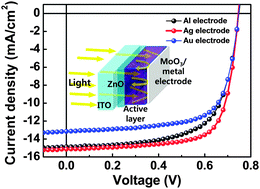Optimal top electrodes for inverted polymer solar cells†
Abstract
Although polymer solar cells (PSCs) have received a tremendous amount of attention in recent years, a number of criteria must be met in order for them to be suitable as practical and commercially feasible power sources, including high performance, good air stability and inexpensive manufacturing. In this contribution, we determine the optimal top electrode for practical PSC fabrication by investigating the influence of the electrode material on the optical properties and performance of PSC devices. The optical properties of eight metals were considered, out of which three metal electrodes (aluminum (Al), silver (Ag), gold (Au)) with the best optical properties were used to prepare inverted PSC devices comprising a blended polymer thieno[3,4-b]thiophene/benzodithiophene (PTB7) and [6,6]-phenyl C71-butyric acid methyl ester (PC71BM). Among the photovoltaic parameters, the short circuit current density (JSC) was most strongly affected by the optical properties of the top electrode. In the results of the experiment, the JSC of the Al and Ag electrode devices was found to be approximately 13% (13.4 → 15.1 mA cm−2) higher than the Au electrode device due to the significant parasitic absorption of light by Au at wavelengths below 600 nm. In contrast, Al and Ag electrodes have high reflectance throughout the visible spectrum, which leads to high JSC. Ag electrodes have relatively good stability to ambient exposure, maintaining over 96% of the original efficiency after 170 hours; this stability is comparable to Au. These data lead to the conclusion that Ag is the optimal top electrode material for use in inverted devices.


 Please wait while we load your content...
Please wait while we load your content...